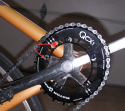Decided to replace the original elliptical chainwheel with a Rotor Q-cx1, used a 42  tooth as original and what a difference. Much better power transfer and a smoother stroke. I have had a slight problem with the de-rail shifting since purchasing the bike, but the new chainwheel solved the problem. The original chainwheel had a flat plate chain guard mounted on the out side, I removed the guard and replaced it with the Q-cx1, as it incorporates thick/thin technology to keep the chain from falling off (it works). The resulting chain line has eliminated any de-rail shifting problems. Anyone who has upgraded to an air shock should give the Q-cx1 a try as it comes in multiple tooth configrations.
tooth as original and what a difference. Much better power transfer and a smoother stroke. I have had a slight problem with the de-rail shifting since purchasing the bike, but the new chainwheel solved the problem. The original chainwheel had a flat plate chain guard mounted on the out side, I removed the guard and replaced it with the Q-cx1, as it incorporates thick/thin technology to keep the chain from falling off (it works). The resulting chain line has eliminated any de-rail shifting problems. Anyone who has upgraded to an air shock should give the Q-cx1 a try as it comes in multiple tooth configrations.
 tooth as original and what a difference. Much better power transfer and a smoother stroke. I have had a slight problem with the de-rail shifting since purchasing the bike, but the new chainwheel solved the problem. The original chainwheel had a flat plate chain guard mounted on the out side, I removed the guard and replaced it with the Q-cx1, as it incorporates thick/thin technology to keep the chain from falling off (it works). The resulting chain line has eliminated any de-rail shifting problems. Anyone who has upgraded to an air shock should give the Q-cx1 a try as it comes in multiple tooth configrations.
tooth as original and what a difference. Much better power transfer and a smoother stroke. I have had a slight problem with the de-rail shifting since purchasing the bike, but the new chainwheel solved the problem. The original chainwheel had a flat plate chain guard mounted on the out side, I removed the guard and replaced it with the Q-cx1, as it incorporates thick/thin technology to keep the chain from falling off (it works). The resulting chain line has eliminated any de-rail shifting problems. Anyone who has upgraded to an air shock should give the Q-cx1 a try as it comes in multiple tooth configrations.


